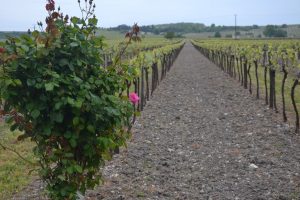Why are rose bushes planted in vineyards?
 On a recent trip to the Charente I took this picture of a rose bush at the end of a row of cognac vines. This placement of rose bushes has created considerable interest from our followers. I therefore thought it would make an ideal Technical Topic.
On a recent trip to the Charente I took this picture of a rose bush at the end of a row of cognac vines. This placement of rose bushes has created considerable interest from our followers. I therefore thought it would make an ideal Technical Topic.
Originally, roses were planted in vineyards as an early warning system. Roses and grapevines typically have the same type of soil and sun requirements. In addition, both are prone to the infestation of a fungus known as powdery mildew. If this fungus appeared on the roses, the vines were sprayed with sulphur to prevent the grapes from succumbing. Downy mildew is another fungus that attacks the green parts of the grape vine. If detected on a rose bush the grape vines were immediately sprayed with a solution of copper sulphate and lime. Another historic reason for the planting of roses dates to when they used horses to pull the plough. The rose’s thorns were thought to deter the horse from hitting the post at the end of the row.
Nowadays, there isn’t a horse and plough in sight. Most vineyards use modern methods to monitor carefully the soil and health of the vines. Rose bushes are no longer required, so why are they still in evidence? Cynics will tell you that they attract tourists who enjoy seeing them in situ. Others will suggest they are purely aesthetic or that they provide food for bees and habitat for insects beneficial to the vineyard. Some believe that roses are tastier than grape vines to pests, so they draw these damaging insects away from the grapes.
Whatever the reasons for planting roses in the vineyards today, you must admit that they add to the milieu and create a sense of nostalgia. These are things of which the Cognaçaise are immensely proud.
